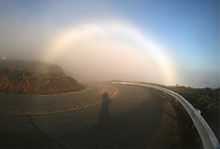Fog bow




A fog bow is a similar phenomenon to a rainbow; however, as its name suggests, it appears as a bow in fog rather than rain. Because of the very small size of water droplets that cause fog—smaller than 0.05 millimeters (0.0020 in)—the fog bow has only very weak colors, with a red outer edge and bluish inner edge.[1]
In many cases when the droplets are very small, fog bows appear white, and are therefore sometimes called white rainbows. This lack of color is a feature of a fog bow which distinguishes it from a glory, which has multiple pale colored rings caused by diffraction. When the droplets forming it are almost all of the same size the fog bow can have multiple inner rings, or supernumeraries, that are more strongly colored than the main bow. According to NASA:
The fogbow's lack of colors is caused by the smaller water drops ... so small that the wavelength of light becomes important. Diffraction smears out colors that would be created by larger rainbow water drops ...[2]
A fog bow seen in clouds, typically from an aircraft looking downwards, is called a cloud bow. Mariners sometimes call fog bows sea-dogs.
Direction
A fog bow is seen in the same direction as a rainbow, thus the sun would be behind the head of the observer and the direction of view would be into a bank of fog (which may not be noticeable in directions away from the bow itself). Its outer radius is slightly less than that of a rainbow.
When a fog bow appears at night it is called a lunar fog bow.[3]
See also
References
- ↑ See:
- Atmospheric Optics: Fogbow
- Auguste Bravais (1847) "Sur le phénomène de l'arc-en-ciel blanc" (On the phenomenon of the white bow in the sky), Annales de Chimie et de Physique, 3rd series, 21: 348-361.
- H. Mohn (February 23, 1888) "Letters to Nature: The fog bow and Ulloa's ring," Nature, 37: 391-392.
- James C. McConnel (March 22, 1888) "Letters to Nature: The fog bow," Nature, 37: 486-487.
- James C. McConnel (1890) "The theory of fog-bows," Philosophical Magazine, series 5, 29 (181): 453-461.
- ↑ APOD: 2006 November 15 - A Fog Bow Over California
- ↑ Lunar Fogbow
External links
- Photos and explanation of fogbows at Atmospheric Optics.
- Fogbow image gallery at AKM website.
- Fogbows at Glows, Bows and Haloes site.